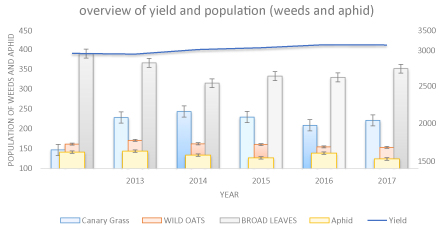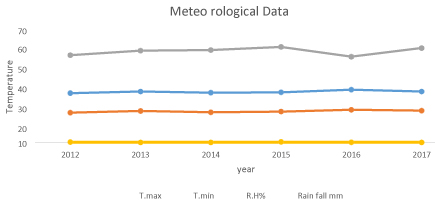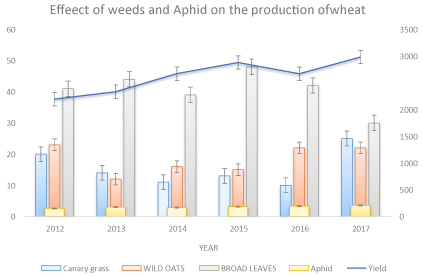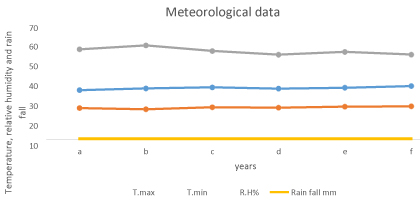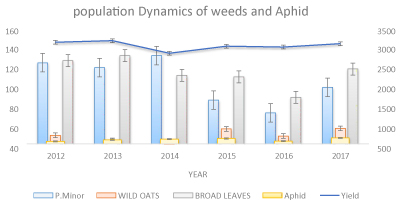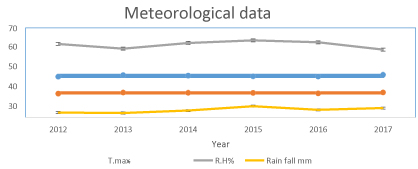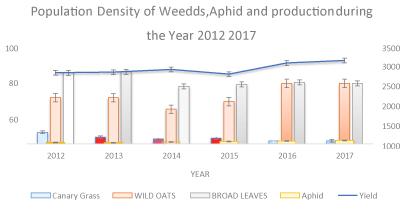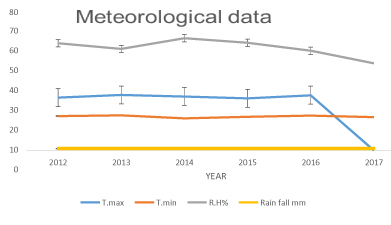Journal Name: Journal of Applied Microbiological Research
Article Type: Research
Received date: 20 March, 2019
Accepted date: 29 March, 2019
Published date: 05 April, 2019
Citation: Basit A, Irshad M, Salman M, Abbas M, Hanan A, et al (2019) Population dynamics of weeds (canary grass, broad leave and wild oats), Aphid and Abiotic factors in association with wheat production in Southern Punjab: Pakistan. J Appl Microb Res. Vol: 2 Issu: 1 (17-23).
Copyright: © 2019 Basit A, et al. This is an open-access article distributed under the terms of the Creative Commons Attribution License, which permits unrestricted use, distribution, and reproduction in any medium, provided the original author and source are credited.
Abstract
In agro-ecosystem weed crop interaction is a popular biological concern that hampers the yield and production of the crop. The study was conducted during the period of 2012-2017 to check the effects of weeds (canary grass, broad leave and wild oats) and aphid on the yield of wheat. The survey was conducted at four different districts Muzaffargarh, Dara Ghazi Khan, Layyah and Rajanpur under the department of Pest Warning and Quality Control, Punjab, Pakistan. To increase the yield of crop, control of weeds is considered to be essential in developing countries. As the harmful effects on environmental conditions have led to stronger pressure to minimize the usage of herbicides and insecticides. Over the next century 50% demands of food is forecastle, and in-depth quantitative analysis of crop yield, insect and insecticide weeds and herbicides is to be maintain the economic and environmental issues. To take account the behavior of the farmer a Bayesian hierarchical model was built, including absolutely their awareness of weed and weed control practices. Yield losses in wheat due to weeds is 23% an average southern punjab, but actually the yield losses due to the weeds is 8%. These result shows that due to increase of weeds and aphid population the yield is ultimately decreased. Yield also decreased by the environmental factor also.
Keywords
Aphid environmental factor; Wheat; weeds.
Abstract
In agro-ecosystem weed crop interaction is a popular biological concern that hampers the yield and production of the crop. The study was conducted during the period of 2012-2017 to check the effects of weeds (canary grass, broad leave and wild oats) and aphid on the yield of wheat. The survey was conducted at four different districts Muzaffargarh, Dara Ghazi Khan, Layyah and Rajanpur under the department of Pest Warning and Quality Control, Punjab, Pakistan. To increase the yield of crop, control of weeds is considered to be essential in developing countries. As the harmful effects on environmental conditions have led to stronger pressure to minimize the usage of herbicides and insecticides. Over the next century 50% demands of food is forecastle, and in-depth quantitative analysis of crop yield, insect and insecticide weeds and herbicides is to be maintain the economic and environmental issues. To take account the behavior of the farmer a Bayesian hierarchical model was built, including absolutely their awareness of weed and weed control practices. Yield losses in wheat due to weeds is 23% an average southern punjab, but actually the yield losses due to the weeds is 8%. These result shows that due to increase of weeds and aphid population the yield is ultimately decreased. Yield also decreased by the environmental factor also.
Keywords
Aphid environmental factor; Wheat; weeds.
Introduction
Being a staple diet, wheat (Triticumaestivum L.) is a major food grain crop. Among the cereal crops it is a main source of proteins and carbohydrates for both animal and human beings. It contains protein (11-16.5%), starch (60-90%), fat (1.5-2%), vitamins (B-complex and vitamin E) and inorganic ions (1.2-2%) [1,2]. It contributes almost 3.1% to GDP and 14.4% of the value added in agriculture. It contributes 14.4 percent of the value added in agriculture and 3.1 percent to GDP. Wheat is cultivated on an area of 8.80millionhectares with an annual production of 24.21 million tons with an average yield of 2750 kg ha-1 [3]. Different constraints are accountable for low yield i.e. use of poor-quality seed, low seeding rate, improper sowing time, improper use of irrigation and fertilizers, salinity and water logging. However, in reducing wheat yield, weeds disruption is the key factor [4-8].
Weeds are unwanted plants which infest crop and ultimately reduce production of the crop. There are countless reports on the inhibitory effects of weeds on crop [9,10]. As weeds compete with the crop plant by holding a space complicated wheat crop competition. Plant reduce the growth rate by anything that minimize this space [11]. Available moisture contents and water requirement for a growth point of view is a primary interest from the stand point of competition with the crop. Weeds play a major role in reducing wheat yield; up to 45 species of weeds have been reported in different wheat growing areas in Pakistan (Qureshi&Bhatti,2001) [4]. Phalarisminor Retz., Coronopusdidymus (L.) Sm., Medicagodenticulata Willd., Poaannua L., Rumexdentatus L., and Chenopodium album (L)., have been reported as densely populated and the frequently occurring weeds of wheat in the country [12].
In Pakistan many insects attack on the wheat crop (Triticumaestivum L.) and the main damage is due to aphid. Yield losses directly by aphid is 35-40%; this is due to sucking cell sap of the plant and transmitting viral and fungal disease indirectly in plant [13]. Population dynamics of the aphid also depend on the abiotic factors [14,15]. Aphid population is increased during the spring season, and at the same time as a natural re agents check on this pest bio control like Coccinellids is also increased [16]. Through direct feeding, aphids significantly decrease the yield and its infestation causes severe damage on the inflorescence and distortion of leaves.
Climate change is a vital issue, has its effectives all over the Globe. Different climatologist reported that change in climate may cause variation in temperature [17-21] and precipitation [17,18,22-33]. It is also attributed to the unabated increase in greenhouse gases, including fluorinated gases, carbon dioxide, methane, and nitrous oxide, which bring changes in rain pattern, temperature, and negative effects on water and land resources, floods, and droughts. Climate change is considered to be a global phenomenon; however, its impacts are more widely felt in the developing countries of Asia and Africa, due to their greater vulnerabilities and lesser ability to mitigate the effects of climate change. Because most developing nations- including Pakistan are agriculturebased economies, their agricultural sector is affected the most due to direct exposure to nature. Therefore, the major impact of climate change is on agricultural production due to changes in rain pattern, temperature, floods, droughts, and negative effects on water and land resources [13,34]. The present study was conducted to evaluate the yield losses in wheat crop due to the weeds, infestation of aphids and environmental condition. The investigations were projected to manage this serious problem and to boost up the wheat production keeping in view the quality and quantity of the production.
Materials and methods
Study area and sampling design
From 2012 -2017 the field survey was conducted in four districts (MuzaffarGarh, Dera Ghazi Khan, Layyah and Rajanpur) under the Department of Pest Warning and Quality Control, Punjab, Pakistan for weeds and insect pest management” between the years November 2012 to April 2017 in each rabi (winter) season. In the present study, 35 villages from each district were selected. From each district, 35 circles were selected and from which 35 villages were selected and wheat growing farmer were selected from each village. The observations were recorded in each week from these farmer fields. Observations on Canary grass, Broad Leaves, Wild Oat sand aphid were recorded randomly from each field plot. Showing of wheat by project farmer was done from 15th November to 10th April at a different spacing under rain fall situation. Wheat varieties were selected from showing purpose and regular agronomic practices.
Survey of farmers and herbicide treatments
Farming practices and crop yield information (ploughing and mechanical weed control system pesticide and fertilizer use) and general information about the farm. The response was 98% representing 30 farms. Herbicide use was described by the name and the concentration of each of the active ingredients and the day or week of application. Herbicides were further classified as monocotyledon specific, dicotyledon specific or broad spectrum. Crop yields were not available for 3 of the 30 farms.
Weed and insect pest surveys
In winter wheat Botanical surveys were carried out once during the flowering to milk-ripening stage of crop in each year. For each of the 30-35 fields, surveys were carried out in ten quadrats (4 m2) at 10 m intervals in line from the border of the field towards the center, perpendicular to the tracks made by farm machinery within the field. The first quadrat was 20 meters from the edge of the field. For each quadrat, weed species were recorded as either present or absent, irrespective of the number of individual plants, giving a list of species present in each quadrat. And aphid population was also checked by suitable pest scouting method.
Meteorological data:
Environmental data consisting of maximum and minimum air temperature, relative humidity, rainfall, wind speed and solar radiation were recorded by conventional instruments installed at observatory of meteorology unit, Regional Research station. The relationship between weather parameter was established by using simple correlation.
Results
In M. garh Maximum yield was observed in the 2017 year as compared to the previous year’s (Figure 1). Because the number of weeds i.e. broad leaves wild oats and the number of aphid is decreased. Yield was highly effected by the broad leaves canary grass, wild oats and aphid. In which year the incidence of the weeds and the aphid is high the production was decreased. And when the incidence of the weeds and aphid is gradually decreased, the yield is also increased. In which year the yield is high it is because the competition of the crop plant with weeds is low.
Figure 1: Relative proportion of weeds and aphid (on density basis) and yield in kgha-1from year 2012-2017 in Muzaffargarh.
Yield of the wheat crop compared with the environmental factor temperature relative humidity and rain fall presenting in figure 2. Yield is directly affected by the environmental condition. Maximum yield was observed in those year when the temperature is relatively high and relative humidity is low and the rain fall is minimum. Because if the temperature is low and humidity is high it spread many fungal and virus disease rust and smut was occurred which ultimately decreased the yield of the crop. Maximum and minimum yield was observed in year 2017 and 2013 respectively.
Figure 2: Meteorological Data during the year 2012-2017 in Muzaffargarh.
We first attempted to determine the positive relationship between yield weeds and aphid because the yield was highly affected by the weeds and aphid. Similar trends were found the yield is gradually increase with the decrease of the weeds density presenting in the figure 3. But in Dara ghazi khan the density of wild oats is maximum as compared to the other weeds and aphid. But the yield is maximum in 2017 year as compared to the previous year. The yield of the wheat is gradually increased from the 2012 to 2015 and in 2016 and it was decreased. But in 2017 yield was increased because due to the minimum weeds density and aphid.
Figure 3: Effect of weeds and aphid (on density basis) and yield in kgha-1from year 2012-2017 In D.G .KHAN.
Yield of the wheat crop is highly affected by the environmental condition. Because early sowing wheat have more production as compared to the late sowing. In November environmental condition was more favorable for its growth and ultimately the production was increased. The yield of wheat is maximum in 2017 and minimum in 2012 respectively presenting in figure 4.
Figure 4: Meteorological data from 2012-2107 In D.G.KHAN.
Maximum yield was observed in the 2017 year as compared to the previous year’s presenting in figure 5. Because the number of weeds i.e. broad leaves p. minor and the number of aphid is decreased. In Layyah Yield was highly effected by the broad leaves P. minor, wild oats and aphid because the incidence of the weeds and the aphid is high the production was decreased during this year. And when the incidence of the weeds and aphid is gradually decreased, the yield is also increased. In which year the yield is high it is because the competition of the crop plant with weeds is low. Minimum yield was observed in 2014 because the density of p. minor and broad leave weeds is maximum as compared to the other years.
Figure 5: Population Dynamics of weeds and aphid (on density basis) and yield in kgha-1 from year 2012-2017 in Rajanpur.
Yield of the wheat crop compared with the environmental factor temperature relative humidity and rain fall presenting in figure 6. Yield is directly affected by the environmental condition. Maximum yield was observed in those year when the temperature is relatively high and relative humidity is low and the rainfall is minimum. Because if the temperature is low and humidity is high it spread many fungal and virus disease rust and smut was occurred which ultimately decreased the yield of the crop. Maximum and minimum yield was observed in year 2017 and 2014 respectively.
Figure 6: Metrological Data from 2012-2107 in Rajanpur.
In Rajanpur the yield was highly affected by the weeds and aphid. Similar trends were found the yield is gradually increase with the decrease of the weeds density presenting in the figure 7. But in Rajanpur the density of broad leave and wild oats is maximum as compared to the other weeds and aphid. But the yield was maximum in 2017 year as compared to the previous year. The yield of the wheat was gradually increased from the 2012 to 2014 and in 2015 and it was decreased. But in 2017 yield was increased because due to the minimum weeds density and aphid.
Figure 7: Population Density of weeds and aphid and yield in kgha-1from year 2012-2017 Layyah.
Yield of the wheat crop is highly affected by the environmental condition. Because early sowing wheat have more production as compared to the late sowing. In November environmental condition is more favorable for its growth and ultimately the production was increased. The yield of wheat is maximum in 2017 and minimum in 2015 respectively presenting in figure 8.
Figure 8: Metrological data from 2012-2107 Layyah.
Discussion
In the present study, response to various weeds was highly variable between the different wheat varieties. Different weeds caused 60-76% reduction in grain yield in different crop. Genotypic variation in response to weed infestation has also been reported for other crops [10].
In present study, influence of different weeds, pest population and environmental factors on wheat crop yield was assessed in accordance with cropping years. Weed infestation is one of the main causes of low wheat yield in Pakistan, which may reduce yield by 25 - 30% [35]. In year, 2017 maximum yield was observed as compared to previous five years, it was because of better weeds and pest control. Better weed control always boosts up grain yield due to less plant to plant competition.
This study also showed that abiotic factors like temperature, rain fall and relative humidity also affect the wheat grain yield. Maximum yield was observed when there was high temperature and less relative humidity and rainfall, this condition favors crop plant against diffident fungal and viral diseases. The statement of also supports our results that low rainfall and high temperature increases the wheat grain yield [36].
In cropping year, 2017 wheat grain yield of district Layyah and RajanPur was maximum as compared to past five years because of better weed and pest control. Sowing time is also a major factor in better wheat grain yield. It was observed that early sowing wheat crop give more production because of more no. of tillers due to favorable environmental conditions and better development of grain due to longer growing period [37]. These results are in line with those reported by [38].
Conclusion
Among a cereal crop wheat has greater importance. Result of different studies shows that weeds growth is due to the different sowing time. Hence the yield of wheat is highly influenced by the weeds. It is necessary to study these aspects so the yield of wheat seed can be improved. In the present study we indicate that the yield of crops is highly suppressed with the increase of the weeds (canary grass, broad leave and wild oats).
Acknowledgement
The authors are grateful to Prof. Dr. Sohail Ahmed for his valuable comments and proof reading of the manuscript.
There are no references
